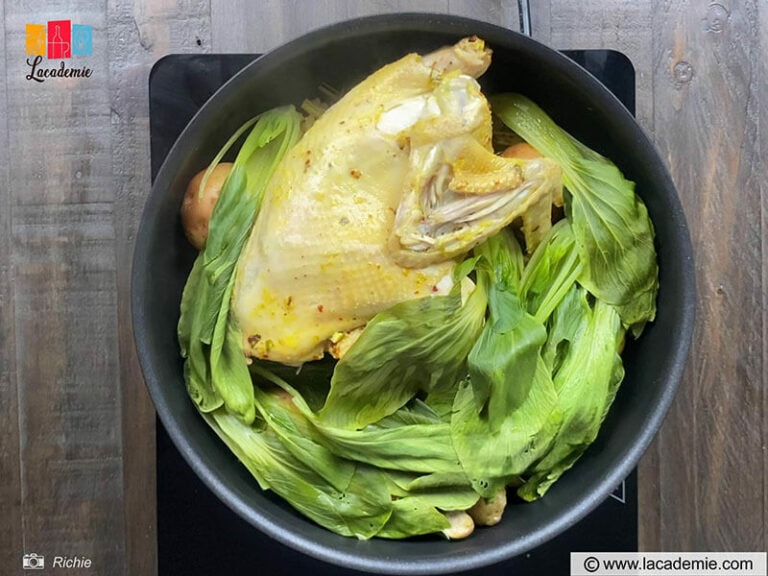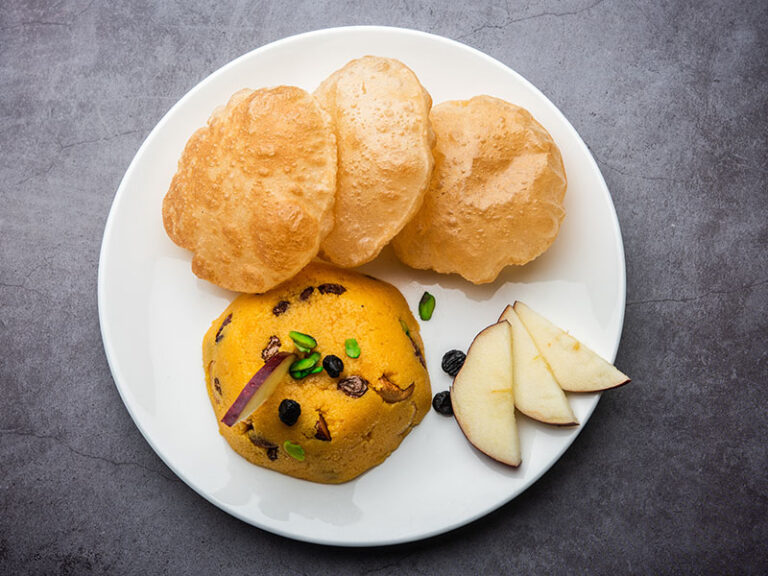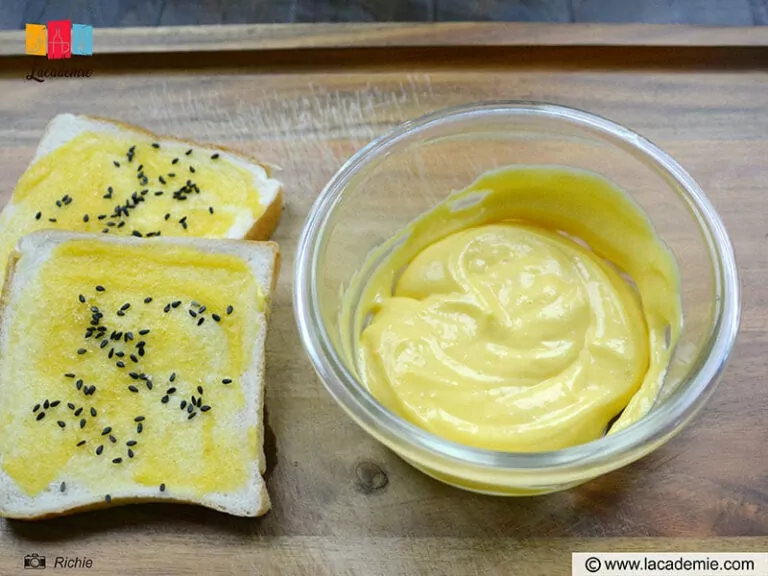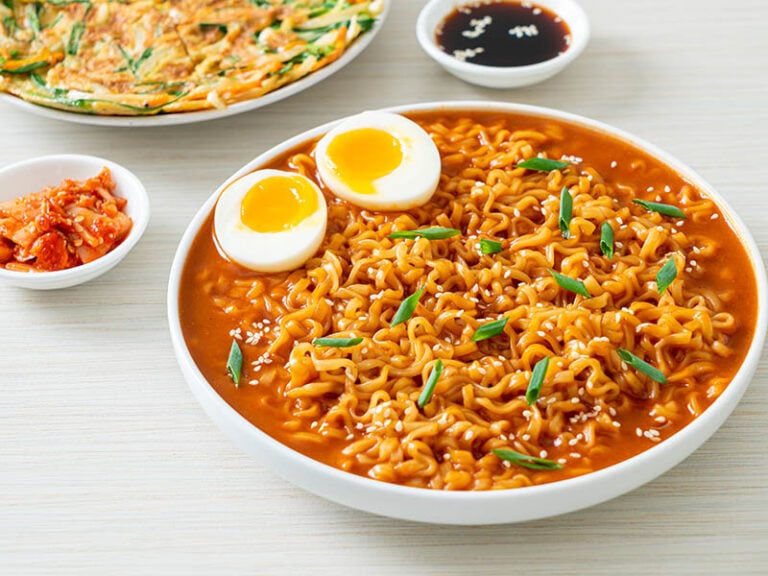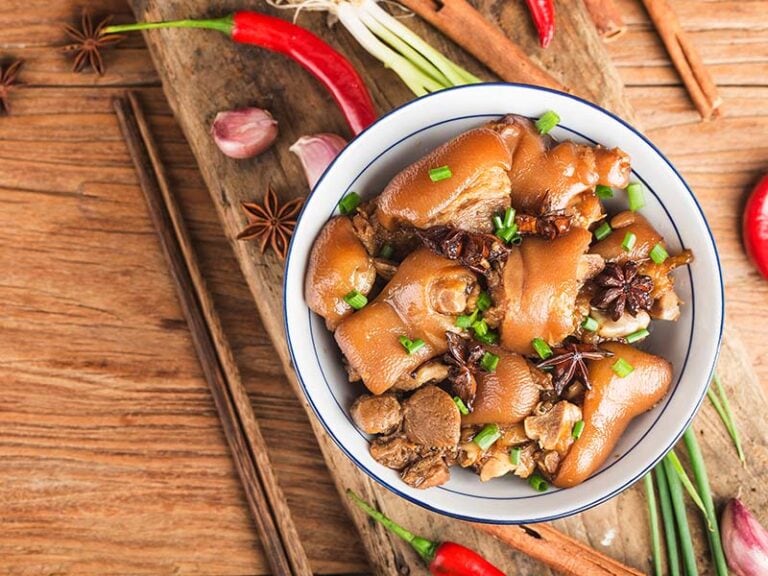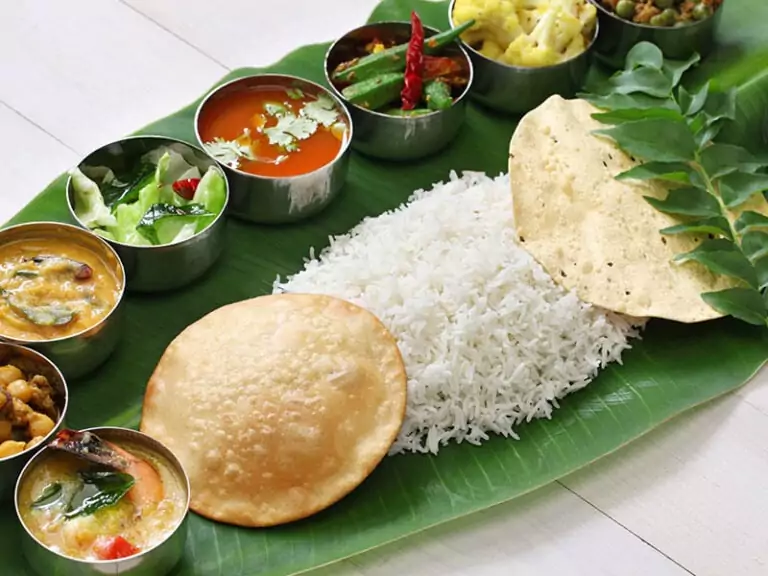What is Pho? Even if you are not a gourmet who is always looking for the most interesting things to eat, you probably have come across this word before when searching for the most mouth-watering specialties in Asia.
And in case you haven’t, this is your lucky day. I am going to tell you why Pho is so special. You will learn everything, from how to pronounce it (more difficult than it sounds, trust me) to why it should be part of your daily meals. Keep reading to discover this tantalizing delicacy!
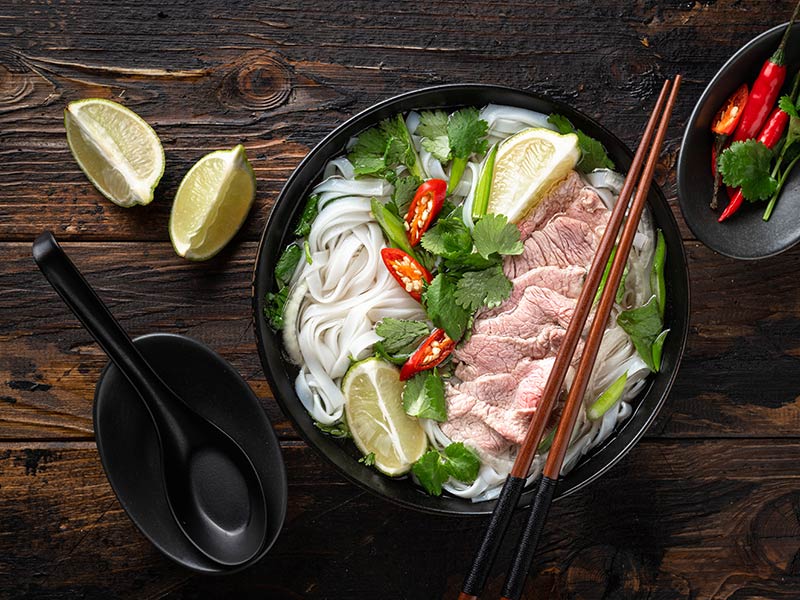
What Is Pho In Vietnamese Cuisine?
Pho is a unique noodle variety from Vietnam. While it is quite popular, the finer details about its history or serving etiquette may elude many people. After reading this article, you will surely appreciate what made Pho so special.
The Peculiar History Of Pho
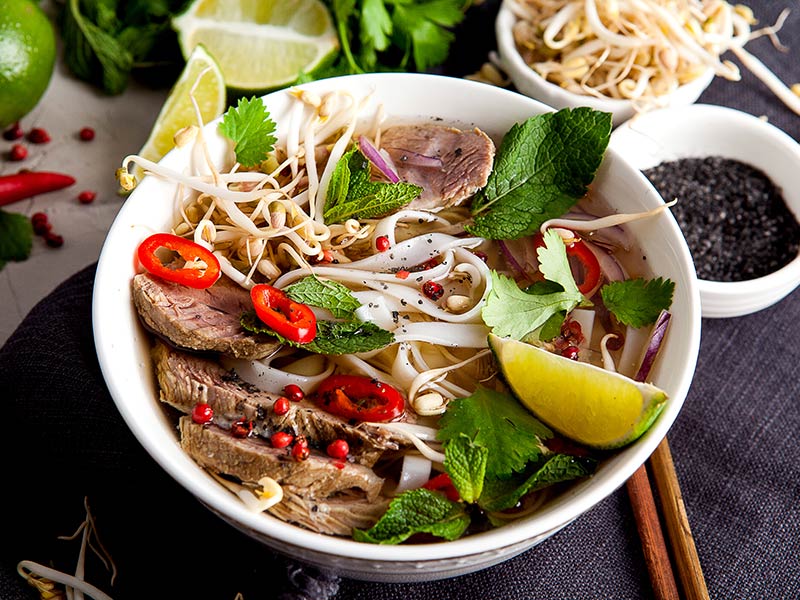
Pho originated from Nam Dinh province (Northern Vietnam) in the early 20th century. And that is probably the only clear thing about the origin of this dish because there are many theories about how it came about.
One thing can be sure, though. Pho was born from a mix of traditional Vietnamese dishes, French cuisine, and, possibly, the influence of Chinese cooking.
A prevalent theory says that Pho is an adaptation of a French one-pot beef stew called pot au feu, which has the same sound and main ingredients as the Vietnamese noodle dish.
Another one credits a similar Chinese dish whose name means “beef with noodles” as the inspiration for Pho.
But in the end, Pho could be a truly Vietnamese creation with a few French (or Chinese) tweaks. For one thing, both pot au feu and the Chinese “beef with noodles” specialty differ significantly from Pho in terms of ingredients and cooking method.
Besides, according to people from Van Cu and Dao Cu villages (Nam Dinh province), one of the birthplaces of Pho, they had enjoyed similar dishes long before the arrival of the French.
Anyway, Pho has entered the mainstream and become one of the most recognizable Vietnamese foods in the world. Its history and taste have become ingrained in the Vietnamese consciousness: you can not separate Pho from the country’s cuisine.
Pho started out as a delicacy in northern Vietnam. After the end of the Indochina War (1945 – 1954) and the exodus of refugees to the south, the dish traveled to the other side of the country, underwent major changes, and became a new, popular food.
In the years following the Vietnam War (1955 – 1975), refugees brought Pho to other countries and helped it achieve massive popularity. Today, you can easily order a warm, tempting bowl of Pho everywhere. But whether it is authentic or not is another matter.
How To Pronounce Pho?
Foreigners who come to Vietnam regularly encounter this problem. They know the word, they understand what it means, but they can not convey it to the natives.
So let’s study from their lesson and learn how to pronounce it right now. To pronounce Pho, you have to know how Pho is originally written in Vietnamese first: it is like this “Phở”.
Vietnamese is a tonal language, which means it uses pitch dynamics to convey more meaning compared to English. The closest English word equivalent you can draw would be “Fuh”. It may also sound like the French word “Feu”.
Can you pronounce Pho like a native?
What Is Pho Made Of?
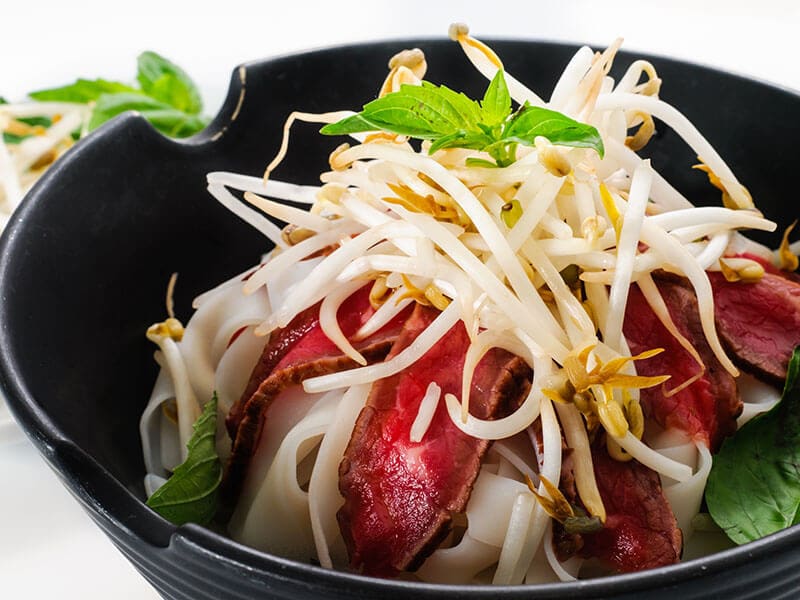
Pho consists of broth, rice noodles, meat, and herb garnishes, with the most important factor being the broth. This is the soul of Pho. A deep understanding of broth-making is necessary to create authentic Pho.
The broth is generally made by simmering cow bone and pig bone separately or together for a more intense flavor. But that’s not all: flavorful Pho broth contains numerous varieties of spices, such as cinnamon, star anise, ginger, cloves, etc.
Rice noodle is another important piece of Pho. In Vietnam, it is called “Bánh phở”. They are available in markets, supermarkets, or grocery stores. Depending on which region you are in Vietnam, the rice noodles in Pho can have different widths.
Garnishes and toppings are quite plentiful and diverse. Pho usually goes with dipping sauces, spicy chili paste, or extra-fatty broth (nước béo).
If you order the southern version of Pho, you may expect a lot of accompanying herbs and greens. The most common option is bean sprouts, followed by Thai basil, garlic chives, cilantro, etc. Meanwhile, northern Pho tends to come with bagel twists and only a few herbs.
As for the meat, most Pho versions use beef and chicken as the main source of protein, Beef Pho is always far more popular but the deliciousness of chicken Pho is undeniable. However, if you simply ask for Pho, most vendors will automatically take the beef variety as your order.
You can enjoy your Pho with many different types of beef: rare, medium rare, well-done, flank cuts, briskets, tendons, tripe, and beef balls. Don’t forget to tell specifically what kind of beef you like when ordering.
In terms of chicken Pho, you can choose the following cuts: thighs, breasts, innards, and even immature chicken eggs. For the full experience, I recommend you to try both types of Pho.
How Do You Eat Pho?
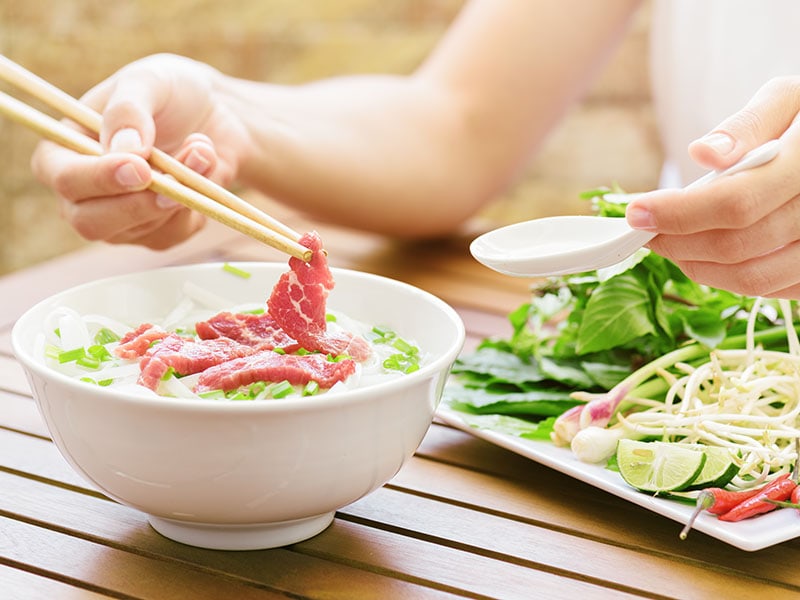
Pho can be enjoyed just like any noodle dish: with chopsticks and a spoon. The pair of chopsticks is for picking up the noodles and toppings while you scoop the fat broth with the spoon.
When a bowl comes out, you first need to try its broth and rice noodles without any additional topping or sauce first. This process will let you know if that bowl of Pho is a good bowl or not.
After you try its broth, you set aside a small plate to put in hoisin and chili sauce. This small plate is what you need to dip your beef in every time you take a bite. But this only applied to southern Pho.
In northern Vietnam, the first step is still correct, but the locals don’t use a separate plate to dip their beef in. If they want to season their meat, they would just simply use grounded chili paste directly in their bowl.
That is the standard procedure for eating Pho, though different people have their own way of eating it. For someone from outside Vietnam, however, this is the best way to understand Pho.
If you are still confused about how to enjoy Pho, then check out this visual demonstration
Why Should You Eat Pho?
Finally, the important question for any who has never tasted Pho before. Just what makes it so special that an entire article has to be written about it?
Availability
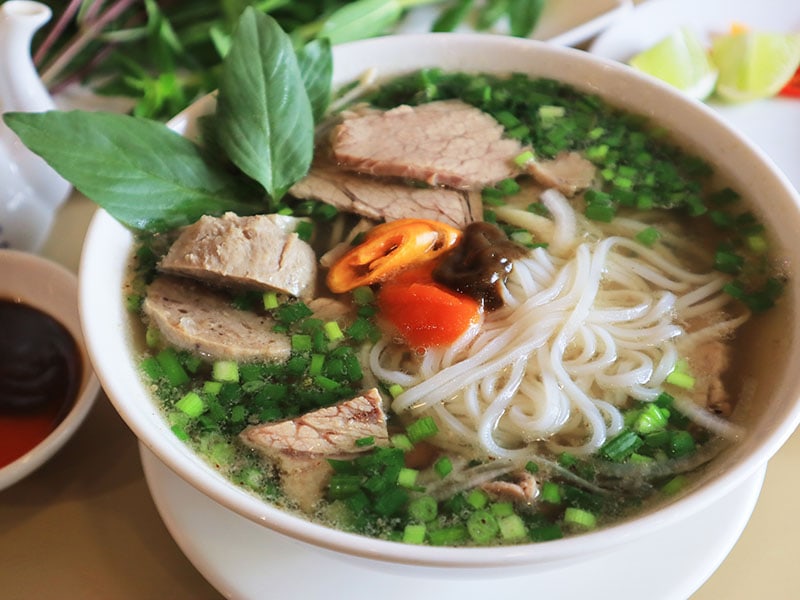
Pho is literally everywhere in Vietnam. You can savor it in both roadside stalls and fine restaurants across 63 provinces of the country.
This dish is also equally popular worldwide. Almost every major Vietnamese community abroad comes with a few places that sell good Pho. But it is common to find a Pho restaurant in places with few Vietnamese people living nearby.
The Vietnamese national street dish is extremely fast to prepare and order. A fresh bowl of Pho only takes 3 – 5 minutes of waiting. This delicacy offers a very different experience compared to fine dining. It is like a kind of fast food, but a hotter and more delicious one.
A Doorway To Experience True Vietnamese Cuisine
Pho can offer you valuable insight into Vietnam cuisine like no other. While comparing Pho in each region, you can also learn about what makes Vietnamese love Pho so much. It embodies the history of Vietnam and its people.
Vietnamese cuisine is known for being quite refreshing and healthy, which Pho aptly demonstrates. A hot pot of Pho with non-fried meat, gluten-free starch, and plenty of greens is surely wholesome than any kind of greasy fast food you may get.
And if you omit the fatty toppings and choose your dipping sauce carefully, this iconic noodle dish will be even more suitable for your diet.
Nutritional Value
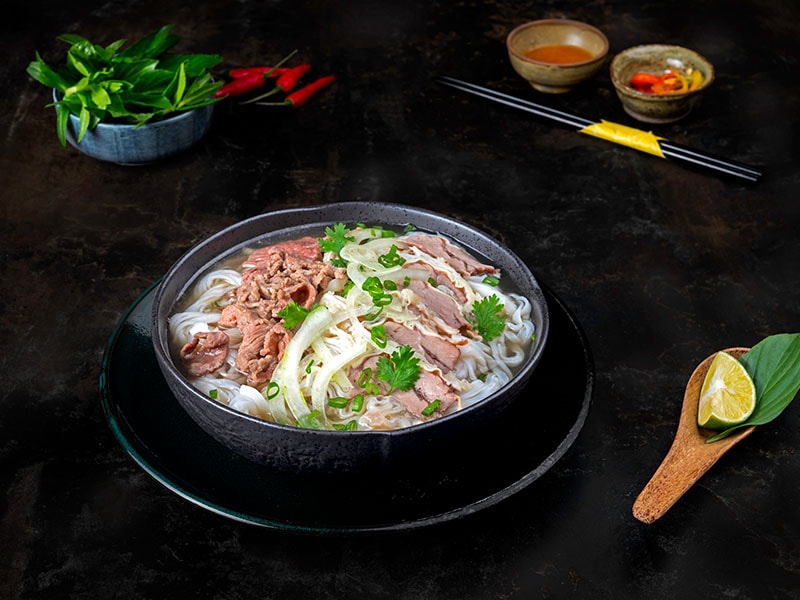
Pho qualified as a full meal because of its big serving and the combination of meat and many different herbs. There is surely no meal as nutritious and delicious as Pho in Vietnam.
Many ingredients in Pho offer invigorating health benefits. For example, its bone broth contains collagen glucosamine and chondroitin. Those substances promote joint health and provide much-needed vitamins, amino acids, and minerals for the body (2).
Moreover, Pho is eaten in tandem with a variety of herbs, giving it many anti-inflammatory properties. The herbs and spices also offer polyphenols, which help against stress and many chronic conditions, such as cancer, high cholesterol level, and heart disease.
On average, Pho contains 573 calories per bowl, with 4.7 grams of fat, 23 grams of proteins, and 2912.4 mg of sodium (3).
Common Types Of Pho You Should Know About
Pho is a type of noodle dish that comes in many varieties in different regions of Vietnam. So let me introduce to you some notable examples.
Beef Pho – Vietnamese Beef Noodle Soup
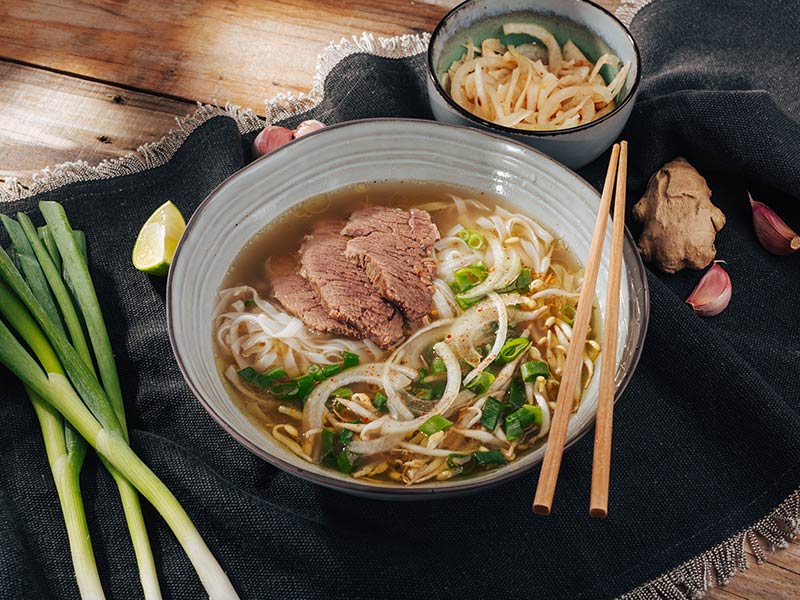
Like its name, beef Pho serves Pho with a focus on beef. There are two main types of beef Pho. You can let the chef cook the beef for you and serve it well-done in your bowl. Alternatively, you can choose to cook the beef yourself.
If you do it that way, a separate plate of beef will be served, and you have to cook the beef using the broth in your own Pho. This way, you can freely choose how rare your beef is yourself.
Pho Ga – Vietnamese Chicken Noodle Soup
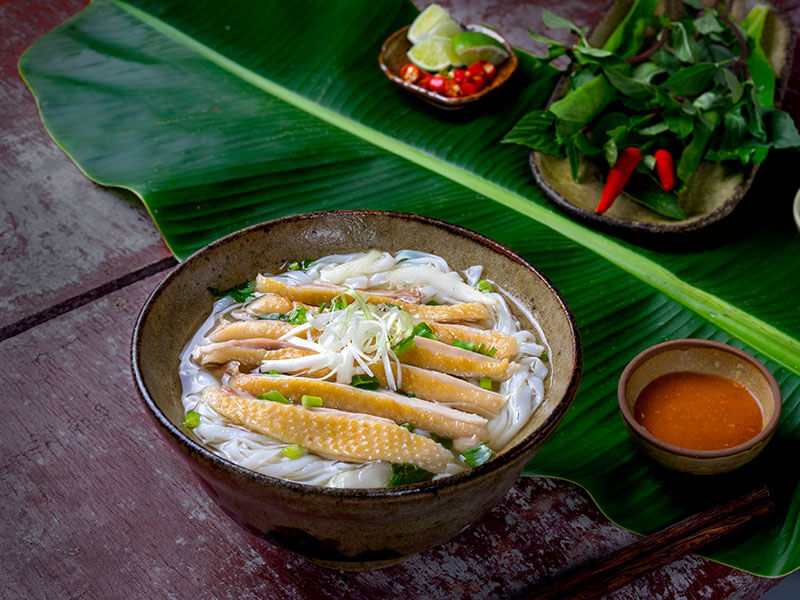
Pho Ga is another popular type of Pho. It shares the same concept as Beef Pho, but its outward appearance is a little bit different. Instead of a brown-like bowl, you get a more colorful bowl with yellow shredded chicken on top.
Its taste is also deep and exquisite. It is a twist on the original Beef Pho and carries the same deepness in taste.
Pho Xao – Vietnamese Stir-Fried Noodles
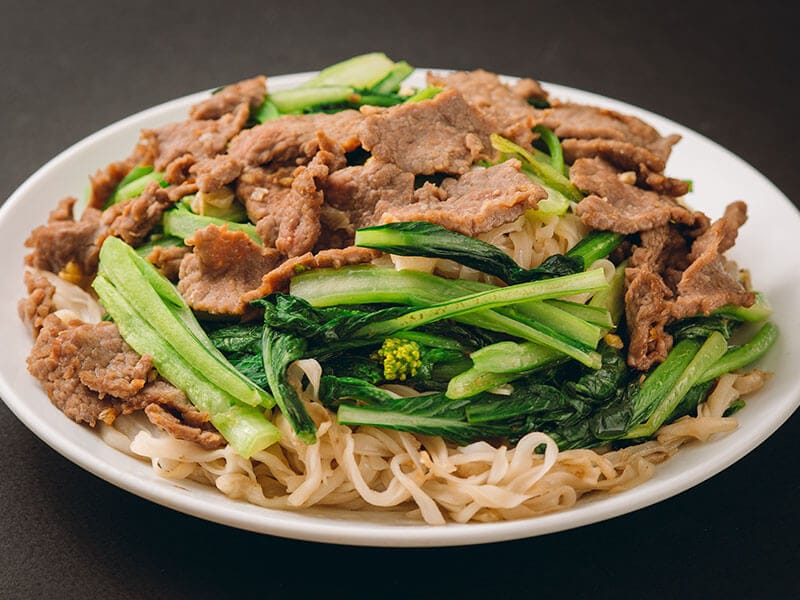
Are you bored of traditional Pho and are looking for something more varied? Then Pho Xao might be just what you are looking for. Pho Xao is a delight to eat if you are in a hurry but still want to enjoy Pho.
In this dish, instead of relying on the broth to elevate the taste, you focus on stir-frying the rice noodle instead. Because of this, Pho Xao is much quicker to make as it does not require any simmering to complete.
Pho Chua – Vietnamese Sour Noodle Soup
Pho Chua is a variant of Pho with high vitamin C content. Like Pho Xao, the broth is less important here. Instead, a brown tamarind sauce plays a more important role.
Unlike other types of Pho, Pho Chua serves its broth in another separate bowl and becomes something like a side dish. Its meat part and garnishes are also a little different from the norm: you can expect chicken innards and pickled papaya.
The Differences Between The Northern And Southern Versions Of Pho
Pho originated in northern Vietnam and was later adopted into southern cuisine, which leads to disparities in how to serve Pho in both regions. Some differences here might lead you to love northern or southern Vietnam differently.
1. Broth
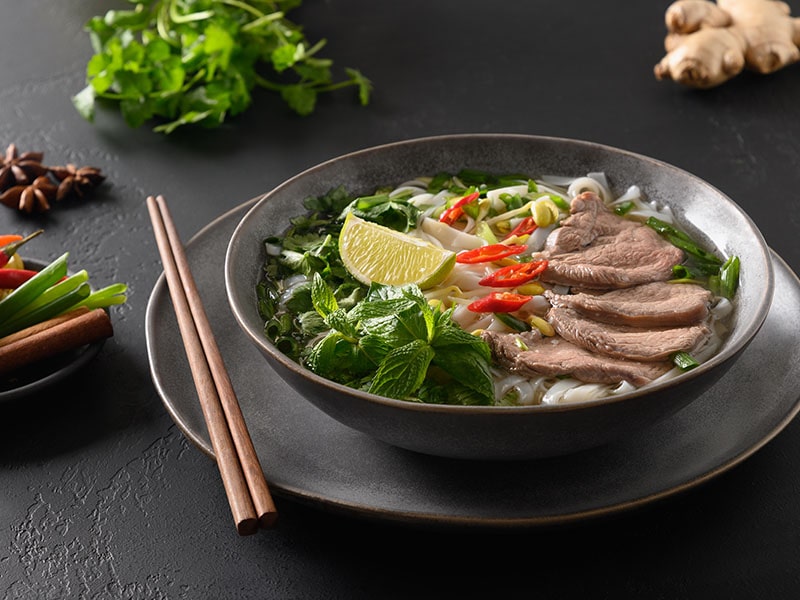
The biggest difference between the northern and southern versions of Pho would be the broth. The broth of the northern version is made using only beef bones. But in the south, the broth is made using far more ingredients such as beef bone, chicken bone, dried shredded squid, and more.
This process makes the former far clearer and “purer” than the latter due to having fewer ingredients in its broth.
2. Taste
As a direct result of different ways of making broth, the taste of Pho differs wildly between the two versions.
In northern Vietnam, Pho can be described as having a clear, mild yet full of flavor. Its saltiness is also pronounced. By contrast, if you taste Pho in south Vietnam, you will find the flavor to be more complex and, most importantly, sweeter.
3. Toppings
Another important difference lies in the toppings and garnishes. In the, you are always given a free plate of many kinds of vegetables to eat with Pho, especially bean sprouts. You can eat them raw or cook them partly in the hot broth first.
Given the hot and humid climate of the region, that seems to be a natural choice. But on the other side of the country, locals only savor Pho with a few aromatic herbs. Instead, this variant usually goes with crisp, nutty, and oily bagel twists.
4. Noodles
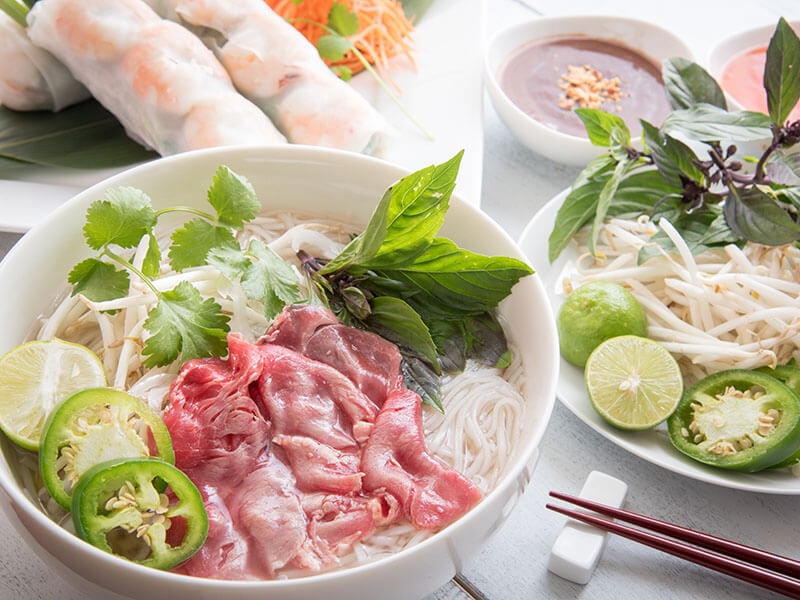
If you dive even deeper, you will realize that there are even differences in how to order Pho. In the north, when you order Pho, people will serve you a bowl with flat and big noodles. Meanwhile, the default southern choice of noodles is always small and thin.
5. Seasoning
Let’s talk about what the two versions have in common first. Wherever you travel in Vietnam, people always serve Pho with Vietnamese fish sauce (nước mắm) dotted with sliced chilies as well as a few lime wedges.
But people also add grounded chili paste and vinegar garlic to their Pho in the north. Meanwhile, you can choose from hoisin sauce and chili sauce when enjoying the southern variant of this dish.
What Are Some Other Vietnamese Dishes Like Pho?
Pho is a big part of Vietnamese cuisine, but it is not the only one. There are so many noodle soup dishes outside of Pho that you can explore and savor. Let’s check them out!
Bun Mam – Fermented Fish Noodle Soup
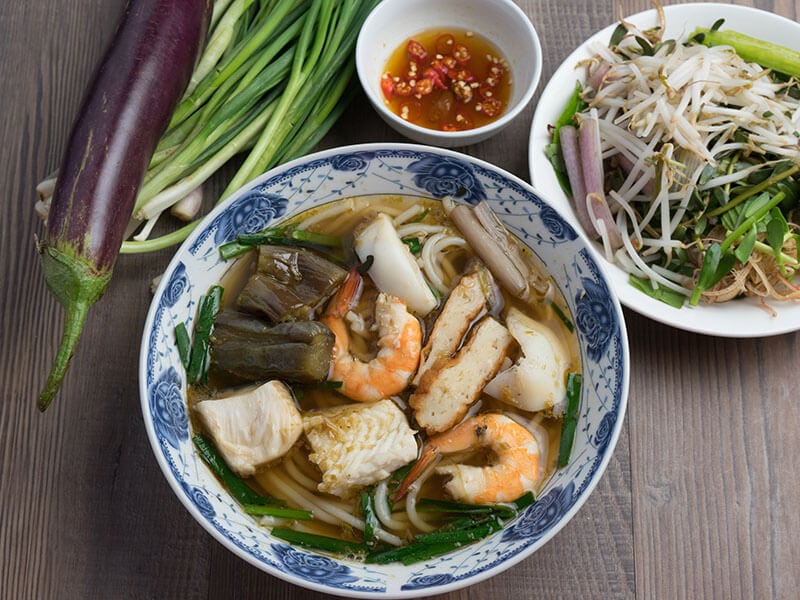
Bun Mam is not a purely Vietnamese creation; it was brought into Vietnam from Cambodia. Nowadays, it is often available in the Mekong Delta region of Vietnam.
Originally, this dish used Prahok (very pungent fermented fish paste of many kinds of fish), but when brought into Vietnam, Prahok was replaced with local fermented fish paste that is more subtle and delicate in taste.
Still, the Vietnamese version is an acquired taste that isn’t for anyone. You probably won’t like it on your first try, but you will gradually come to appreciate its broth’s uniqueness.
Bun Bo Hue – Hue-style Beef Noodle Soup
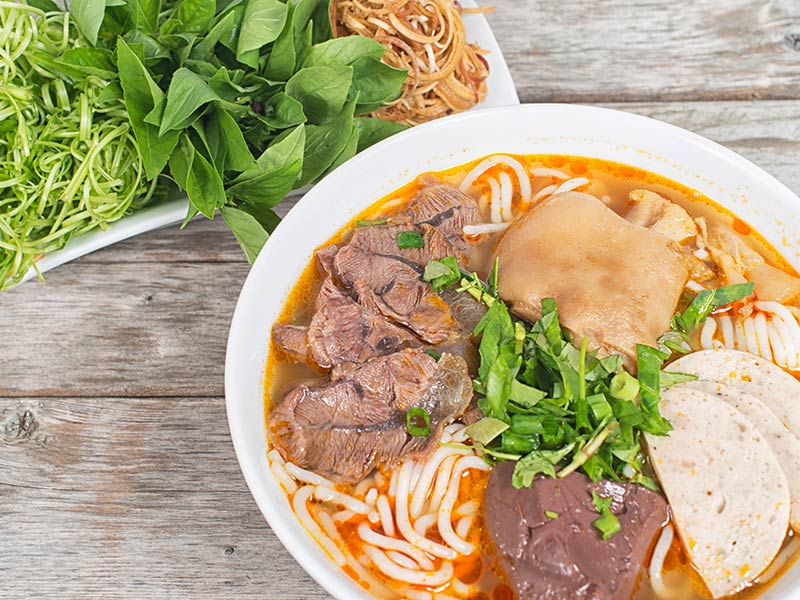
Some people see Bun Bo Hue as the closest comparison to Pho, which I agree with. Bun Bo Hue originated from Hue, a city in central Vietnam. As Hue was the seat of the former imperial court, Bun Bo Hue can be seen as a symbol of old Vietnam.
Bun Bo Hue distinguishes itself by its spicy, umami-packed flavor. This reflects in the color of its broth: an opaque red signifies its spiciness. While its garnishes share many similarities with Pho, real Bun Bo Hue must have the flavors of lemongrass and salted shredded shrimp.
Follow this easy guide for a hot, home-cooked meal with Bun Bo Hue.
Bun Rieu Cua – Crab Noodle Soup
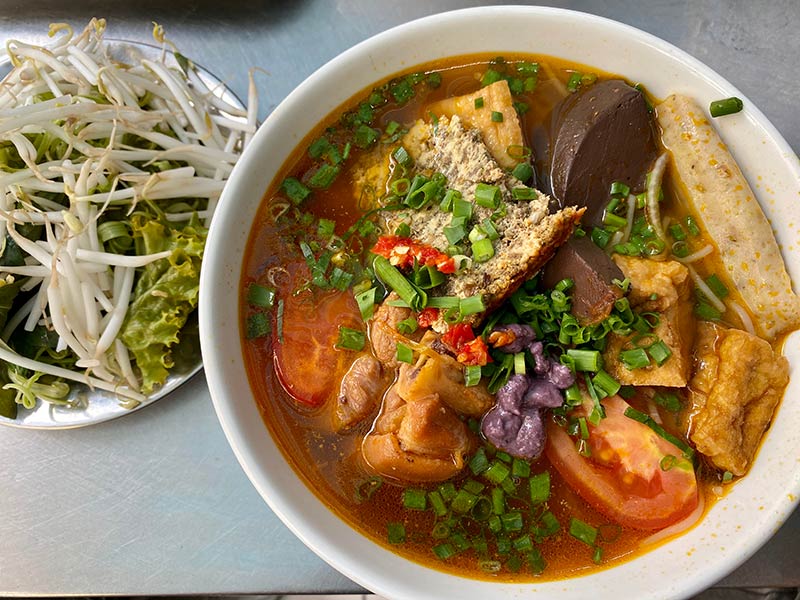
Bun Rieu Cua derives its deliciousness from the distinct flavor of freshwater crab. If you are a fan of crustacean dishes, then this dish might be just for you.
But this dish also utilizes a lot of congealed pig blood and fermented fish paste. Don’t be alarmed by those ingredients: give them a try, and you may discover a love for them.
Its flavor can be summed up in the word “summery”: not only is it taste fresh, but its broth is also very light, which is a big difference from Pho.
Bun Moc – Vermicelli Noodle Soup
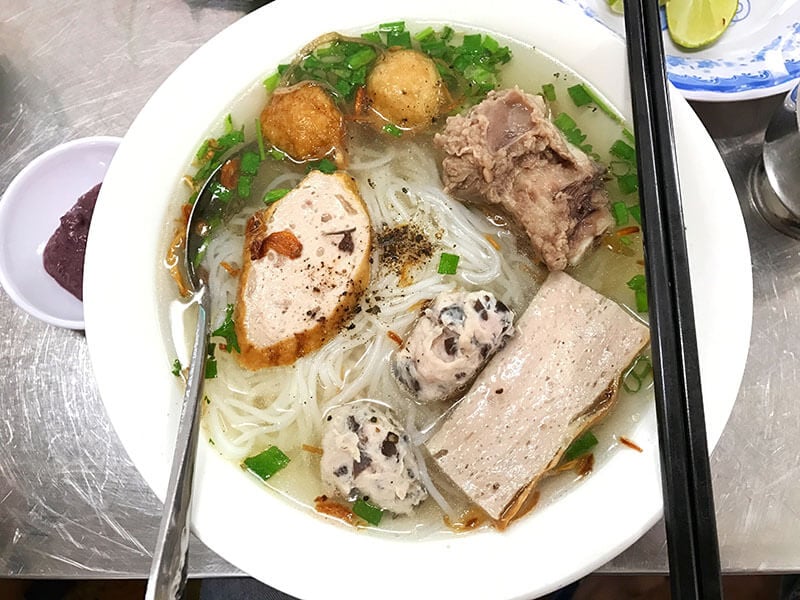
Bun Moc got its name from its ingredient: “Moc” here means ball-shaped grounded meat (sometimes mushroom is used instead of meat). The flavor of this Hano-originated dish can be a little too mild for you.
It is by no means bland, but Bun Moc emphasizes a clear, mild taste of sweetness. But if you are looking to try a more simple and rural feel of Vietnam, I strongly recommend this dish. Anyway, you can always spice it up with dipping sauces and various garnishing herbs.
FAQs
And that is everything you need to know about Pho. Now, I will answer some common questions that you might harbor after reading through this article. If you have even more questions, then please comment down below.
Pho Is The Jewel Of Vietnamese Cuisine
And with this, you have perfectly understood everything about Pho and possibly a few aspects of Vietnamese cuisine. It would be a shame not to eat Pho now that you have known what it is. Let’s prepare a trip to your nearest Vietnamese restaurant to experience this fantastic dish.
If you find this article helpful, let me know down below in the comment section. Feel free to share your thoughts and possibly some tips for cooking Pho or the best restaurants to enjoy it. Also, please share this post with your friends so that more people will know what Pho is. Many thanks!
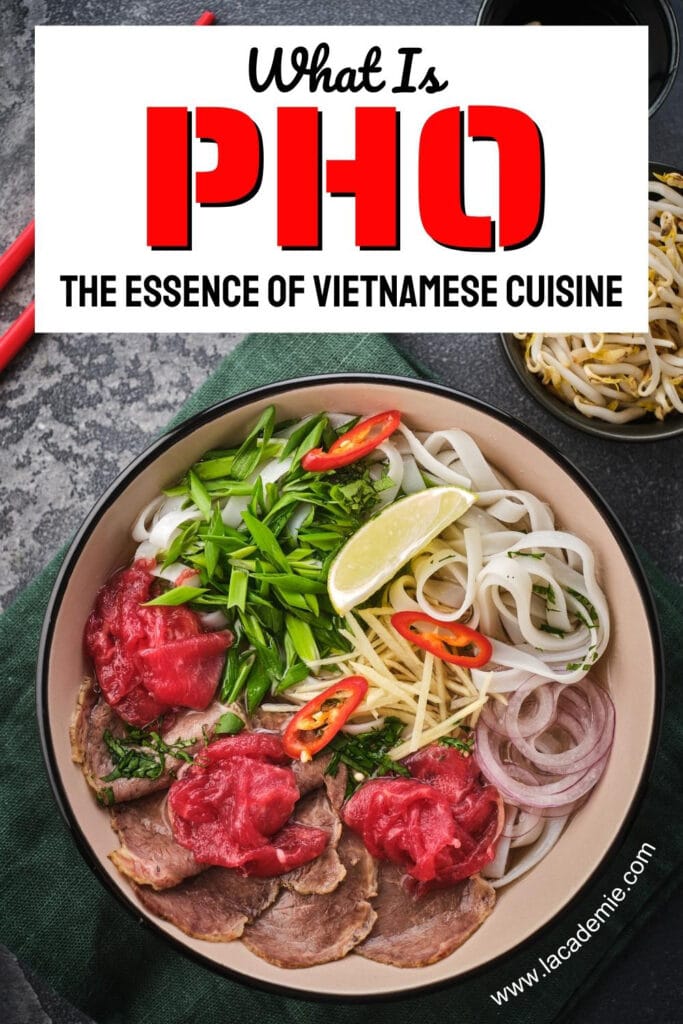
References
- En.wikipedia.org. 2022. Pho – Wikipedia.
- Healthline. 2022. What Is Bone Broth, and What Are the Benefits?.
- Menu.ha.ucla.edu. 2022. Beef Pho.

